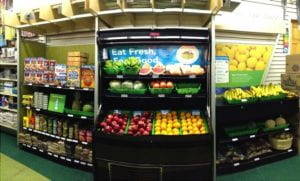
Rather than offering a large quantity of “snack food”, such as cookies, chips, two liter sodas, and candy. Our ideal neighborhood corner stores contain healthier food options such as fruits and vegetables. How do we plan on stocking the shelves? Simple, by allowing the newly trained community gardeners to sell their produces to corner stores and mini marts. This will not only bring healthier food options to residents, but also reactivating the local economy while decreasing the prices of corner store goods.
If you were to walk into a corner store currently offering fresh produce, it is quite common to hear fellow shoppers complain about how expensive an apple is in comparison to the
supermarket ten miles away. However, this is due to the fact that independent store owners often cannot afford to pay distributors who carry produce seeing as they tend to require higher-volume orders and deliveries (Bloch). So when store owners do find ways to buy smaller volumes of produce they tend to pay higher prices per item, meaning the customers end up paying more as well. By allowing corner stores to buy the locally grown food it will lower purchasing cost for both the store owners and shoppers. We also suggest that the city should build more supermarkets throughout, and not only in suburban locations. It is important to note that corner stores have survived for decades in these urban settings. The question then becomes, why would these supermarkets not survive if they are providing what the people need.